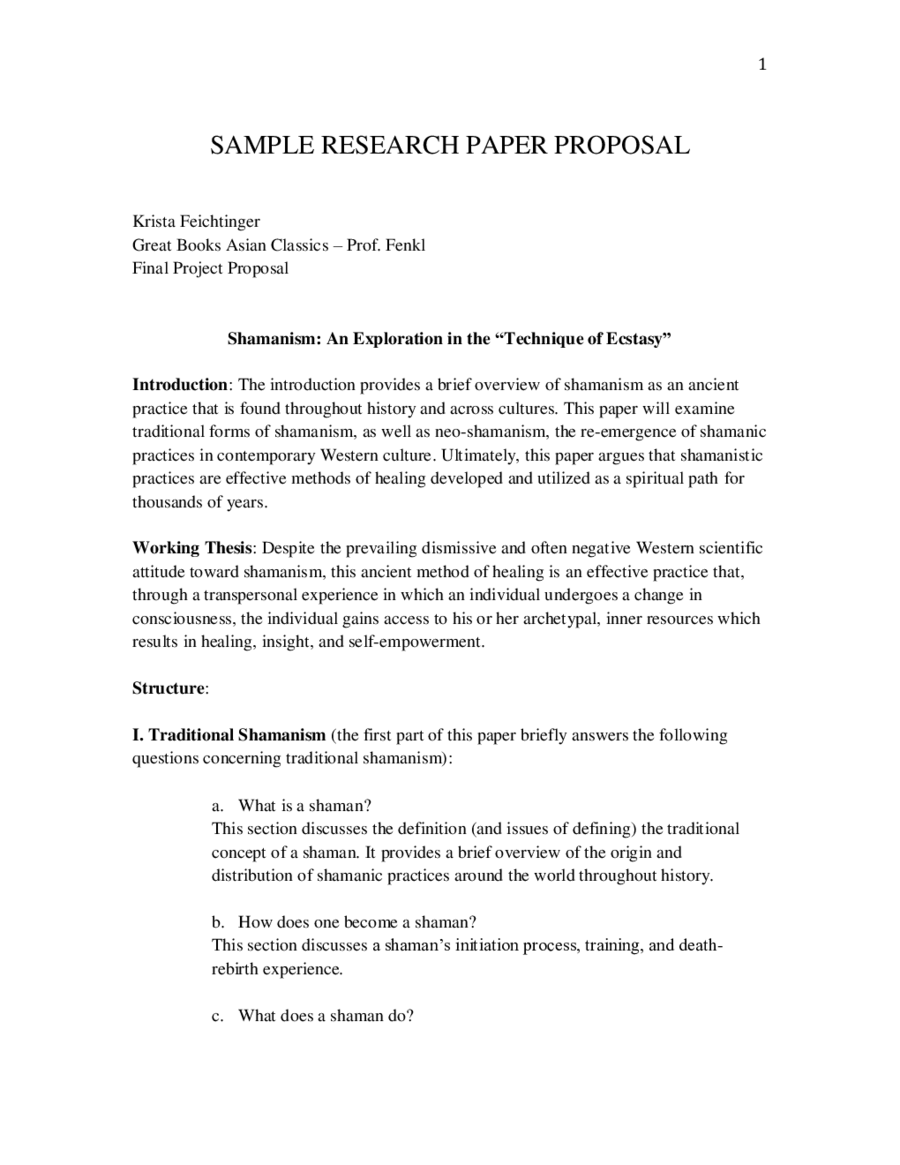Fillable Printable Research Proposal Sample
Fillable Printable Research Proposal Sample

Research Proposal Sample
1
SAMPLE RESEARCH PAPER PROPOSAL
Krista Feichtinger
Great Books Asian Classics – Prof. Fenkl
Final Project Proposal
Shamanism: An Exploration in the “Technique of Ecstasy”
Introduction: The introduction provides a brief overview of shamanism as an ancient
practice that is found throughout history and across cultures. This paper will examine
traditional forms of shamanism, as well as neo-shamanism, the re-emergence of shamanic
practices in contemporary Western culture. Ultimately, this paper argues that shamanistic
practices are effective methods of healing developed and utilized as a spiritual path for
thousands of years.
Working Thesis: Despite the prevailing dismissive and often negative Western scientific
attitude toward shamanism, this ancient method of healing is an effective practice that,
through a transpersonal experience in which an individual undergoes a change in
consciousness, the individual gains access to his or her archetypal, inner resources which
results in healing, insight, and self-empowerment.
Structure:
I. Traditional Shamanism (the first part of this paper briefly answers the following
questions concerning traditional shamanism):
a. What is a shaman?
This section discusses the definition (and issues of defining) the traditional
concept of a shaman. It provides a brief overview of the origin and
distribution of shamanic practices around the world throughout history.
b. How does one become a shaman?
This section discusses a shaman’s initiation process, training, and death-
rebirth experience.
c. What does a shaman do?
2
This section examines the methods of healing performed by shamans, (for
either individuals suffering from illness or for a community as a whole)
including: healing of the spirit, herbal healing, bodywork, divination, soul-
leading, ceremony and ritual. It also provides information about a shaman’s
guides or “spirits” and the processes by which a shaman travels to the “other
world” (or induces a “shamanic state of consciousness”). A brief discussion of
cultures that use various hallucinogenic or mind-altering substances is
included, as well as major archetypal themes individuals experience during
their shamanistic journeying.
d. How does shamanic healing work?
This section examines the practices of shamans and the question of “trickery”
or deception surrounding their methods of healing and how it was viewed as a
form of neurosis or schizophrenia since the Enlightenment.
II. Neo-Classical Shamanism and “core shamanism” (the last third of the paper
focuses on the contemporary emerge of shamanistic practices and the personal, social,
and cultural implications):
a. What is neo-shamanism? What is “core shamanism”?
This section explores the emergence of interest in shamanism in contemporary,
Western world and discusses the concept of “core shamanism” developed by
anthropologist Michael Harner. It examines the contributing factors for this
interest within the context of other non-western healing or spiritual practices
(such as yoga or meditation).
b. What is our contemporary understanding of shamanic methods?
This section examines the psychological (with an emphasis on Jungian
psychology), physiological, and chemical mechanisms involved in altered
consciousness and its ramifications upon an individual.
c. How can anyone use shamanistic practices to heal themselves or others?
This last section explores the personal benefits of using core shamanism as a
healing or spiritual practice.
Conclusion: The conclusion examines the broader personal, social, and cultural
implications of shamanistic healing in the 21
st
century. It discusses how various
shamanistic practices can aid the individual, how it can be used in our community, and
the intended ramifications for the earth at large.
3
Bibliography:
Abram, David. The Spell of the Sensuous. New York: Vintage Books, 1997. Print.
Eliade, Mircea. Shamanism: Archaic Techniques of Ecstasy. Princeton: Princeton
Unversity Press, 1964. Print.
Harner, Michael. The Way of the Shaman. New York: Harper Collins, 1980. Print.
Ryan, Robert E. The Strong Eye of Shamanism: A Journey Into the Caves of
Consciousness. Rochester, VT: Inner Traditions International, 1999. Print.
Wallis, Robert. J. Shamanism/Neo-Shamans: Ecstasy, Alternative Archaeologies and
Contemporary Pagans. London: Routledge, 2003. Print.
Walsh, Roger. The World of Shamanism: New Views of An Ancient Tradition. Woodbury,
MN: Llewellyn Publications, 2007. Print.
Webb, Hilary S. Traveling Between the Worlds: Conversations with Contemporary
Shamans. Charlottesville, VA: Hampton Roads Publishing Company, Inc., 2004.
Print.



